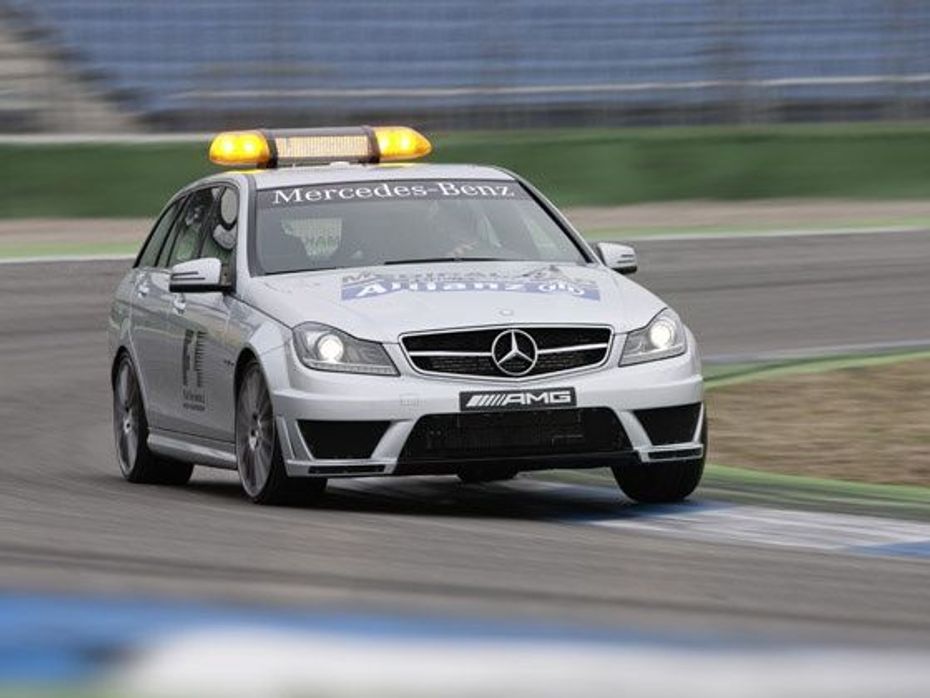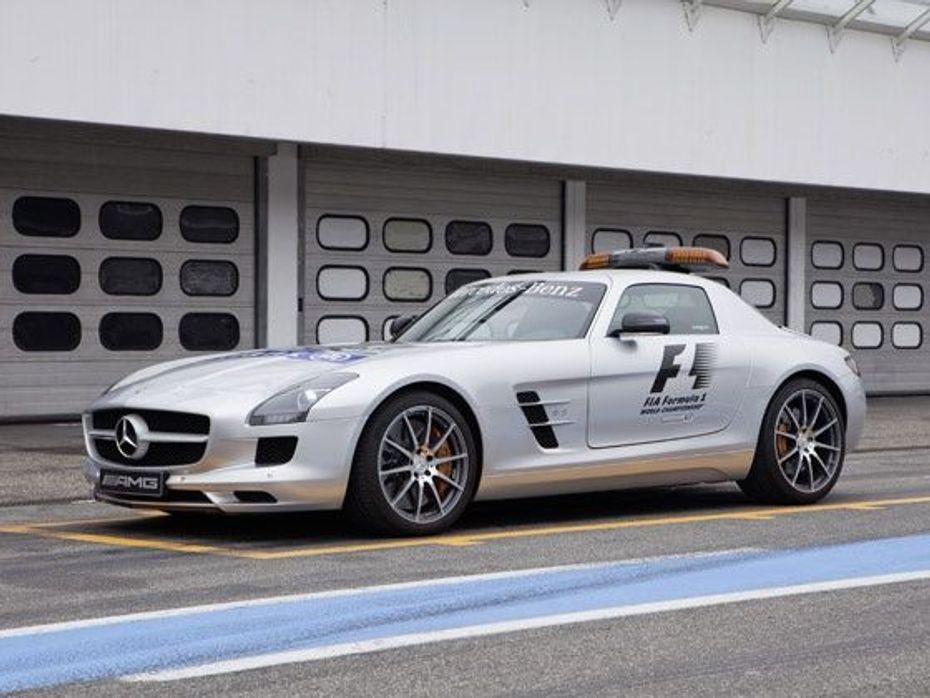
Jawan, Family Man Star Priyamani Raj Drives Home A Brand New...
- Feb 26, 2024
- Views : 2395


The SLS AMG Official F1™ Safety Car is sent onto the track by Race Control whenever an accident or poor weather conditions endanger the safe progress of the race. The gull-wing is driven by German racing driver Bernd Mayländer (39), who has performed this function for the FIA (Fédération Internationale de l’Automobile) since 2000. Mayländer is not only on station for Formula 1 weekends, but also for most of the accompanying series such as the GP2 Series or Porsche Supercup.
During a race the SLS AMG Official F1™ Safety Car is on standby in the pit lane. Its deployment is decided by Race Control. On receiving a radio message, Bernd Mayländer and his co-driver, FIA man Pete Tibbetts (45, from Great Britain), take to the track at the head of the field in order to guide the Formula 1 racing cars safely around the circuit.
Unique vehicle concept for maximum driving dynamics
The Mercedes-Benz SLS AMG has the best possible credentials for this demanding role in the top flight of motor racing: the engine, power transmission, suspension and braking system of the Official F1™ Safety Car are the same as in the standard production SLS AMG. The exceptional technology package for the super sports car ensures perfect driving dynamics and means that no further technical modifications or lightweight design measures are necessary, with the sole exception of the all-new rear silencer, which allows the high-revving AMG V8 naturally aspirated engine to breathe more easily and offers Formula 1 fans an even more emotionally charged sound experience.
The AMG 6.3-litre V8 engine has a peak output of 571bhp at 6800 rpm and a maximum torque of 650Nm at 4750 rpm, enabling the gull-wing model to sprint from 0 to 100 km/h in 3.8 seconds. Fast lap times are a matter of course for the Official F1™ Safety Car, otherwise the Formula 1 cars' tyres and brakes would cool down too quickly, while their engines could overheat.
The unique vehicle concept is a key factor in ensuring outstanding driving dynamics: the aluminium spaceframe body keeps the vehicle weight down to 1620 kilograms (DIN kerb weight). And thanks to the dry-sump lubrication system, the AMG V8 powerplant can be installed very low down, resulting in a beneficial lowering of the vehicle's centre of gravity. The installed position well behind the front axle, and the transaxle arrangement of the new seven-speed double-clutch transmission on the rear axle, have a positive effect on the weight distribution, which is 47/53 percent (front/rear). Pure motorsport technology is used for the AMG sports suspension: aluminium double-wishbone axles at front and rear ensure outstanding driving dynamics with precise turn-in ability, first-class agility, low mass inertia during fast changes in direction, and therefore high cornering limits.

Double-clutch transmission and ceramic composite brake system
The AMG SPEEDSHIFT MCT 7-speed sports transmission with dual-clutch technology features four modes and allows fast gear changes with practically no interruption in tractive power – in manual mode ("M"), gear changes can be effected in 100 milliseconds. Together with the 3-stage ESP®, the integrated mechanical multi-disc differential lock ensures outstanding traction. Meanwhile, braking distances are minimised and resistance to fading is maximised, even when the brakes are subject to typical race-track loads, courtesy of the AMG ceramic high-performance composite braking system with its generously sized ceramic discs measuring 402 x 39 mm at the front and 360 x 32 mm at the rear. The weight-optimised 10-spoke forged wheels are shod with 265/35 R 19 (front) and 295/30 R 20 (rear) tyres.
Aerodynamically optimised roof light bar incorporating LED technology
Compared to the standard-production SLS, the Official F1™ Safety Car is distinguishable on the outside by its prominent F1 logos, carbon-fibre exterior mirrors and the characteristic roof light bar with integrated TV camera. It sits on an all-new carbon-fibre hood whose shape has been tested in the wind tunnel to ensure optimum airflow at the rear aerofoil. The aerofoil pops up when the car reaches 120 km/h, and together with the rear diffuser it provides the necessary rear downforce. LEDs are used for all light functions in the aerodynamically styled roof light bar. Their advantages over the previously used bulbs lie in their extremely fast response time and low power consumption.
The two centrally positioned green lights in the light bar are lit up when the Official F1™ Safety Car joins the field, and must first be overtaken by all the Formula 1 racing cars taking part. Once the SLS AMG has assumed the leading position, the outer orange flashing lights are switched on to signal to the Formula 1 drivers that no overtaking whatsoever is allowed. The white stroboscopic lights in the headlamps and tail lights have a general signalling function, and are always flashing while the Safety Car is deployed. A special number plate at the rear, with "Safety Car" lettering and 700 LEDs, provides additional safety in darkness or wet weather. A rear camera is integrated to the left of the number plate, allowing those in the cockpit of the Official F1™ Safety Car to keep an eye on the Formula 1 cars behind via a monitor.

Practical interior with AMG sports bucket seats
Opening the striking gull-wing doors reveals a functional cockpit which – like the exterior – is only slightly different from the standard model. AMG sports bucket seats with black leather upholstery and six-point seat belts ensure optimal lateral support. To the right of the AMG DRIVE UNIT there are four coloured keys operating the various lighting functions and the signal horn, which is activated for safety reasons when entering and leaving the pit lane. The centre console is of carbon-fibre, as are other areas of interior trim. The AMG Performance steering wheel in leather/Alcantara has a specially contoured grip area, a high-grade metal insert and a 370 millimetre rim with a flattened lower section. The seven gears of the dual-clutch transmission are shifted using the two metal shift paddles.
Two central monitors in the SLS AMG cockpit are used to monitor the progress of the race. To the left and right of the lower monitor are the controls for the radio system, which allows Bernd Mayländer and Pete Tibbetts to communicate with Race Control as well as with each other. A second interior mirror lets the co-driver keep an eye on the Formula 1 cars behind. Meanwhile, the "Marshalling System" is integrated in the central display on the instrument cluster and in the lid of the glove compartment: here the driver and co-driver can see exactly the same signals as the Formula 1 drivers in their cockpits. For instance, the various LEDs indicate when yellow or green flags are being waved. LEDs indicating the status of the roof light bar, along with an on-board camera angled towards Bernd Mayländer, are mounted at the front end of the dashboard.

Jawan, Family Man Star Priyamani Raj Drives Home A Brand New...

Mercedes-AMG E 53 Hybrid Performance Sedan Breaks Cover: Top 5...

India-Bound Mercedes EQG, The Electric G-Class, Gets A Global Debut...

Indian Filmmaker R Balakrishnan Brings Home A Brand New Mercedes-Benz...

Mercedes-Benz EQG 580 Breaks Cover: An Electrified Icon Is Born

Maruti Suzuki Rock N Road: Redefining the SUV Experience

Bosch Car Service: Your Trusted One-stop Destination for Car...

3 New Major Design Details Mahindra XUV 3XO Will Pack Over...

You Can Now Name Skoda India’s Upcoming Sub-4 Metre SUV

Tata Curvv: A Much Clearer Look At Its Interior Ahead Of Its Unveiling
India's largest automotive community